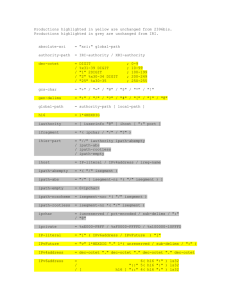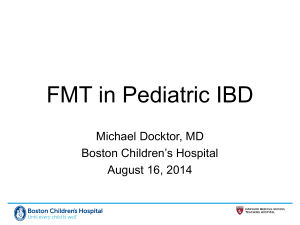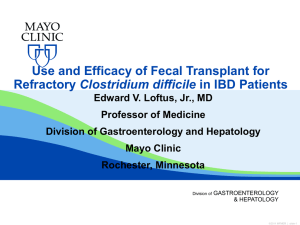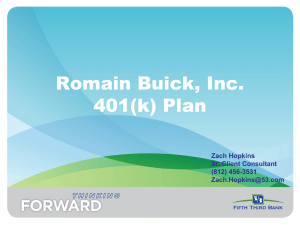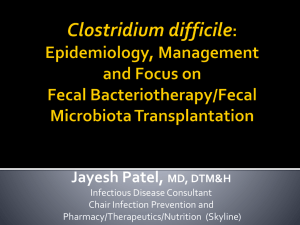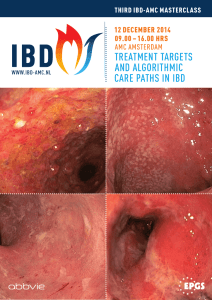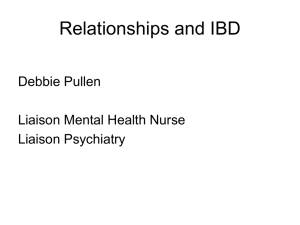Case Management Conference
advertisement
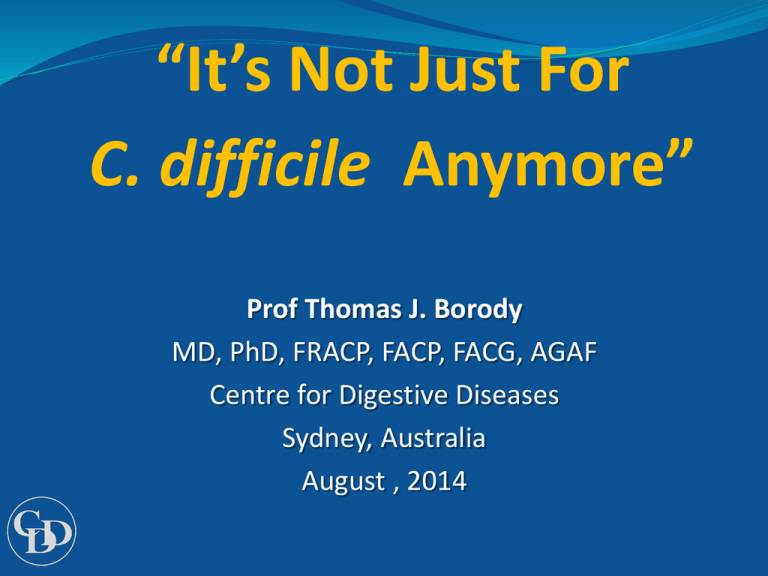
“It’s Not Just For C. difficile Anymore” Prof Thomas J. Borody MD, PhD, FRACP, FACP, FACG, AGAF Centre for Digestive Diseases Sydney, Australia August , 2014 Disclosure statement TJ Borody makes the following disclosures: RedHill Biopharma: scientific advisory board (honorary) Salix Pharmaceuticals: research grant CIPAC Consultant (honorary) GSK, Salix Pharmaceuticals, Giaconda Pty Ltd: stock Patents: in various fields, including FMT Pecuniary interest in Centre for Digestive Diseases, where FMT is a treatment option Centre for Digestive Diseases Established October 1984 Free standing GI endoscopic Clinic 6 Gastroenterologists and a staff of 47 FMT since 1998; > 4500 procedures No restrictions on use in CDI nor non – CDI indications Restriction on “supply” 3 4 FMT Outside Relapsing CDI-1 FDA Guidance : FMT to treat C. difficile not responding to standard therapies • CEBER July 2013 A. FMT in CDI and IBD - Common (Issa et al I B Dis 2008) - Eradicates 90% (Borody UEGJ 2013) - Prolongs remission in minority - Rarely dramatic reversal of IBD 5 FMT IBD :CD CASE 2 47 y male, 1 yr Hx severe CD (previous 3 yr Hx UC) Diarrhea 20-25/day, bleeding, cramping, fatigue – possible surgery candidate, toxin-positive CDI CRP=68.5*, Hb=114* 35mg prednisone, 20mg/wk MTX Symptoms improved somewhat on pre-FMT vancomycin regime Posterior fissures, very severe distal inflammation with pseudopolyps, ulcers and scarring throughout bowel Sigmoid colon, fully-prepped bowel FMT IBD :CD Two-day infusion: transcolonoscopic + next day enema CDI eradicated. At 13 mo F/U: 1-2 formed stools/day. No bleeding, no mucus, no urgency CRP=6, Hb=160 Able to return to work, 20kg weight gain No medication 1 year Best result Sigmoid colon, unprepped bowel FMT Outside Relapsing CDI-2 B. FMT in Non R-CDI - With significant co-morbidities - Immunosuppressed / transplants (Kelly et al 2014 AmJG) - Pregnancy - ? - With non-significant co-morbidities - First time CDI – 2 infusions ~ 100% - D-IBS + CDI – Diarrhoea – occasional cure - C-IBS + CDI – Rare cure with 1-2 FMT Eradication still >90% 8 Disorders associated with altered intestinal microbiome and/or responded to FMT-1 GI • Clostridium difficile infection (CDI) • IBD – UC and Crohn’s* • Sclerosing cholangitis* • IBS • Recurrent diverticulitis* • Halitosis 9 Disorders associated with altered intestinal microbiome and/or responded to FMT-2 Non GI • Arthritis • Autoimmune – ITP* • Autism • Chronic Fatigue Syndrome • Diabetes mellitus and insulin resistance • Acne vulgaris • Mood disorders • Metabolic syndrome • Multiple sclerosis* • Parkinson’s disease Modified : Brandt et al 2013 Am J Gastro 10 FMT: Inflammatory Bowel Disease 1988: Our first case (indeterminate colitis): 2 infusions. Remains cured > 25 years (Borody et al 1989) 1989, Bennet et al: self-treated with FMT, clinical and histological normality. (Bennet et al Lancet 1989) 2003: 6 cases, remain ‘cured’ 1-15 years (Borody et al 2003) 2011: repeated enema infusions – key to IBD 2012: Systematic review. Majority of patients experience symptom improvement (19/25), disease remission (15/24) and cessation of medication (13/17) (Anderson et al, 2012) 2012: 62 cases UC – Prolonged histological ‘remission’ (Borody et al 2012) Reports of isolated cases of dramatic clinical and histological improvement: - Kao et al, 2014 ; Gordon et al, 2014 ; Zhang et al, 2013 Retrospective Review – FMT in UC 62 UC patients – No CDI Simple Clinical Colitis Activity Index (Walmsley) Reduction >4 points – Marked improvement 2-4 points – moderate 0 points – no improvement • 17/62 (27%) – Marked improvement • 26/62 (42%) – Moderate • 16/62 (26%) – No improvement • 3/62 (5%) – Worsened • 17 with marked improvement • Clinically well, formed stool • Endoscopically normal • Histologically normal • “Remission” = 1-24 years 12 Changes by Age Group 16 14 13 13 14 Worsening of Symptoms 12 10 10 No Improvement 8 7 Moderate Improvement 6 4 2 3 1 2 Significant Improvement 0 Group A (18 - 35 years) Group B (36 - 80 years) 13 Retrospective Review – FMT in UC 62 UC patients – No CDI Simple Clinical Colitis Activity Index (Walmsley) Reduction >4 points – Marked improvement 2-4 points – moderate 0 points – no improvement • 17/62 (27%) – Marked improvement • 26/62 (42%) – Moderate • 16/62 (26%) – No improvement • 3/62 (5%) – Worsened • 17 with marked improvement • Clinically well formed stool • Endoscopically normal • Histologically normal • “Remission” = 1-24 years 14 FMT for IBD: UC Case 1: 21 y; 10 yr Hx of severe UC failing Rx (steroids, anti-TNFs) Commenced FMT April 2010: immediate symptom improvement, lowered CRP approx 1 month after starting enemas Completed 26 FMT enemas Pre-FMT Post-FMT 15 FMT for IBD: UC Case 2 33 y M. 8 wk abdominal pain, diarrhoea, mucus + blood. First diagnosis of UC Rx: Standard anti-inflammatory : frequent relapses. Before FMT pre-treated with ciprofloxacin, metronidazole, mesalazine and prednisone. FMT via trans-colonoscopic infusion then daily, twiceweekly, weekly, FMT infusions. After 80 FMT he was recolonoscoped on 14/9/12. He was passing normal stool once per day and was off all drugs then for 7 months and has continued well 16 Before After Rectum Above: Rectum (L), Rectum (R) Sigmoid colon Sigmoid colon Above: Sigmoid colon (L), Terminal ileum (R) 17 FMT for IBD: UC Case 3 38y M. Distal colitis proximal pseudopolyps - sclerosing cholangitis with elevated LFT’s. C. difficile negative 1st infusion transcolonoscopic, followed by daily infusions, then three per week and reducing. 2nd colonoscopy 3/10/2012 after ~ 100 FMT infusions. Once per week for now. Stools formed for a couple of days after infusion and then they became unformed. Next colonoscopy 6/2/2013. FMT now weekly or second weekly. Regained weight. No blood, no mucus and formed stools. Note: Serum ALP fell from 338 to 94 - other liver functions normal. Unprepared colonoscopy showed no inflammation. 18 Before After Sigmoid colon Sigmoid colon, showing mucus, blood Sigmoid colon, showing pseudopolyps Transverse colon Transverse colon Hepatic flexure Hepatic flexure Ascending colon Caecum, infusing FMT 19 FMT for IBD: UC Case 4 53y M, severe distal colitis on immune-suppressants, 5ASA antibiotics facing surgery. Chose recurrent FMT, C. difficile toxin positive found 9/12/2011 - first FMT. Severe distal inflammation. For CDI - had single trans-colonoscopic FMT followed by enema. 7 weeks later he felt “fantastic”. No urgency, no blood, one motion per day. 10/1/2013 – colonoscopy; tubular adenoma removed but mucosa normal. Histology - small numbers of neutrophils within laminar propria - focal mild cryptitis The patient was passing normal formed stools daily. Remains clinically well currently 20 FMT for PROCTITIS: UC Case 5 57y F. Nine y history of refractory proctitis (failed 5-ASA , steroids, antibiotics, probiotics, immunosuppressants and acetarsol). FMT commenced Dec 2007 (69 sessions of infusions) 10 days into FMT immediate clinical response diarrhoea ceased Colonoscopy at 3y and 5y showed no visible or histological inflammation. Now asymptomatic >5y years + off all meds without relapse Rectum - Prior FMT Rectum - Post FMT 21 Before Top: Rectum. Below: sigmoid colon After Top: Rectum showing adenomatous polyp. 22 Below: sigmoid colon FMT for IBD: CD Case 1: 14 y M: Severe Crohn’s ileitis, C. difficile positivity on Prednisone and Imuran. Marked symptoms – poorly controlled. Terminal ileitis - 17/1/2012, FMT 17/4/2012. Instead of doing 2 infusions mother continued home infusions with marked improvement. Total of 60 infusions. No antibiotics. Able to stop Imuran. Acne healed by 7 days. Stools: 1-2 formed per day with all inflammatory parameters normal. 15/11/2012 – Colonoscopy; terminal ileum was totally normal ,no aphthoid erosions, no cobblestoning, no inflammation. Donor was 15 year old cousin. Normal colonocopy March 2014 23 Before After Terminal ileum Terminal ileum Terminal ileum: erosions Terminal ileum Terminal ileum Terminal ileum: no visible inflammation at all 24 CDI IBD • No. of infusions: •SINGLE+ • No. of infusions: •MULTIPLE INFUSIONS •Symptom Reversal •Rapid Cure •Remission • >90% •Symptom Reversal •Slow then rapid REVERSAL •Remission • > 80% •Possibility of Cure: •CURE > 95% VS •Possibility of Cure: •Real Possibility: 10-15% •Measure of Success : •Negative Stool for CDI •No symptoms •Measure of Success : •Normal histology •No Symptoms •Published Evidence •Large volume of small case reports > 1000 patients •Published Evidence •Case reports [n=?12] 25 Experience in IBS First reported by us in 1989 in 55 patients – most IBS @ CDD - most common indication is D-IBS Constipation-IBS more difficult to reverse – requires repeated bowel cleaning and enema infusions Several ‘chronic nausea’ patients treated Several ‘abdominal pain’ only also treated Borody et al 1989; MJA 150: 604 Refractory D-IBS in 13 patients – 70% Improved Pinn et al 2013; Am J Gast 108:S563 26 27 Use of FMT in Neurological conditions FMT in three atypical MS patients at CDD. FMT found to reverse MS symptoms in 3/6 cases resulting in regaining lower motor skills and urinary function and these patients remained asymptomatic after receiving FMT – F/U up to 17 y 28 29 Future of FMT Initial use of ‘frozen’ microbiota preparation Development and use of freeze-dried ‘enteric-coated’ microbiota capsules Expansion of use to growing number of applications including – IBD, IBS, Diverticulitis; Acne; Halitosis; Anorexia Nervosa; Metabolic Syndrome; Autism; Other Neurologic indications; Autoimmune diseases; ?Prevention of Ca colon; Others Post-Antibiotic microbiota restoration 30 CONCLUSIONS FMT in Relapsing CDI is becoming mainstream In IBD FMT shows promise but need for repeated infusions is a barrier Many unanswered questions in IBD – e.g. treat actively using FMT inflamed mucosa or heal first with conventional therapies Future oral enteric coated FMT may be the ultimate therapy – to maintain remission Given the unprecedented sporadic IBD resolution with FMT the mechanisms underlying IBD may need re-examination Other areas are of interest and expose new mechanisms 31


